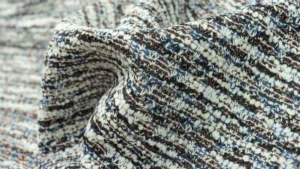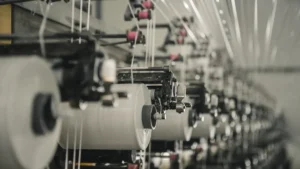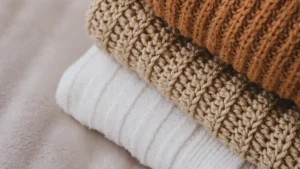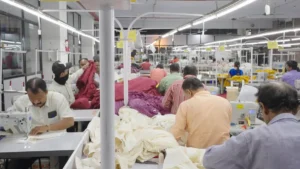
Imagine you have to pick between tightly knitted and loosely knitted fabric for your new clothes. Tightly knitted fabric makes your clothes stronger and last longer. But it can feel stiff and not let air through easily. Looser knits are softer and stretch more, but they might not last as long. Studies show that how tight the knit is changes how your clothes feel and work. It affects things like how air moves, how sweat dries, and how warm you feel. When you choose fabric, always look at both the knit type and the fiber mix to fit what you need.
Key Takeaways
Tightly knitted fabrics are strong and keep their shape. They give warmth. These fabrics are good for fitted clothes and cold weather.
Loosely knitted fabrics feel soft and stretch more. They let more air pass through. These fabrics are great for casual, light, and warm-weather clothes.
Look at fabric loops, stretch, weight, and see-through level. This helps you pick between tight and loose knits. You can find the best one for your clothing style.
Tightly knitted fabrics need less care and last longer. Loosely knitted fabrics need gentle care to stop damage.
Use the quick checklist to match fabric type with your needs. This helps you avoid mistakes when buying knit fabrics.
Fabric Types: Tightly Knitted vs Loose Sweater Knit Fabric

Structure and Appearance
When you look at a sweater, the construction of the fabric tells you a lot about how it will perform. Tightly knitted sweater knit fabric uses small, close loops. This gives the fabric a dense, firm structure. You often see this in a tight sweater knit fabric, which feels sturdy and holds its shape well. Loose sweater knit fabric, on the other hand, has larger loops that spread out more. This creates a more open and airy structure. Loose knits feel softer and stretchier, making them perfect for relaxed, casual sweaters.
Here is a table to help you compare the two types of sweater knit fabric:
Aspect | Tightly Knitted Fabrics | Loosely Knitted Fabrics |
|---|---|---|
Loop Size | Smaller, closer loops | Larger, more spread out loops |
Density | Denser, firmer structure | More open, airy structure |
Appearance | Polished, refined, smooth surface, less visible stitches | Casual, laid-back, slightly see-through, organic look |
Texture | Firm, sturdy, less stretch, less prone to snagging | Soft, plush, very stretchy, more prone to snagging |
Warmth | Excellent insulation, traps air to keep warm | Less warm, allows air circulation, better for mild weather |
Uses | Fitted sweaters, turtlenecks, structured silhouettes, workwear | Ponchos, scarves, oversized or summer sweaters, baby blankets |
You can see that tight sweater knit fabric works best for fitted sweaters and outerwear. Loose sweater knit fabric suits oversized sweaters and layering pieces.
Visual and Tactile Identification
You can spot the difference between tight and loose sweater knit fabric by looking and touching. Tight sweater knit fabric feels smooth and firm. Loose sweater knit fabric feels bumpy or ridged because of the ribbing. When you stretch a tight sweater, it resists and snaps back quickly. Loose knits stretch more and feel flexible in your hands.
Try these tips when you shop for sweater knit fabric:
Look at the loops. Tight knits have small, close loops. Loose knits have big, open loops.
Check the edges. Tight sweater knit fabric has thick edges that do not lay flat. Loose knits have edges that lie flat against your skin.
Do a stretch test. Tight sweater knit fabric stretches less. Loose sweater knit fabric stretches more.
Notice the weight. Tight knits feel heavier and thicker. Loose knits feel lighter and thinner.
Tip: Some qualities, like stretchiness, are hard to judge just by looking. Always touch the fabric to check how it feels.
Sustainability also matters. Tight sweater knit fabric may shed more microfibers during washing because it has more fibers packed into each area. Loose sweater knit fabric can shed more if it is fluffy or hairy. The construction of the sweater affects how much fiber it releases, so always consider this when you choose your fabric.
Key Differences in Fabric Performance

Durability and Longevity
When you pick a sweater knit fabric, you want it to last long. Tightly knitted fabrics are strong and tough. Tests like the ASTM D5034 Grab Test and ASTM D5035 Strip Test show this. Tight sweater knit fabric is harder to tear than loose knits. The table below shows how they compare:
Test Name | What It Measures | Tightly Knitted Fabrics | Loosely Knitted Fabrics |
|---|---|---|---|
Bursting Strength | Resistance to pressure before rupture | High | Lower |
Shrinkage | Change after washing or steaming | Less | More |
Pilling | Formation of small fiber balls | Less | More |
Tear Strength | Resistance to tearing | High | Lower |
Tensile Strength | Breaking strength under tension | High | Lower |
Tight sweater knit fabric keeps its shape after many washes. Loose knits, especially with tuck stitches, can shrink and pill faster. Tight sweaters made on double beds resist rubbing and stretch better. Loose knits, with more inactive needles, stretch out and lose shape. If you want a sweater that looks new longer, pick tight construction.
Stretch and Elasticity
Stretch and elasticity change how your sweater fits. Tight sweater knit fabric does not stretch much but snaps back fast. This is good for fitted clothes that need to keep their shape. Loose sweater knit fabric stretches more and feels softer. But it may not go back to its old size well. Loose knits can sag at elbows and cuffs after wearing. Tight knits keep their shape and give gentle support. For a sweater that hugs your body, choose tight construction. For a loose, flowy fit, loose knits are better.
Drape and Comfort
Drape is how a fabric hangs and moves. Comfort is how it feels on your skin. Studies show knit structure changes both drape and comfort. Tight sweater knit fabric feels firm and holds its shape. It gives a neat, polished look. Loose sweater knit fabric hangs softly and moves with you. Many people think loose knits feel nicer, especially for casual sweaters. The soft feel is better in loose knits. If you want a cozy, relaxed sweater, pick loose construction. For a sharp, neat look, tight knits are best.
Breathability and Moisture
Breathability and moisture control help you stay comfy. Loose sweater knit fabric lets more air pass through. Its open structure makes it cooler and helps sweat dry fast. The table below shows how they compare:
Property | Loosely Knitted Fabrics | Tightly Knitted Fabrics |
|---|---|---|
Air Permeability | Higher due to greater porosity | Lower due to compact surface |
Porosity | Higher (e.g., 55.3%) | Lower (e.g., 45.5%) |
Moisture Transport | Higher, quick sweat transfer | Lower, slower moisture movement |
Spreading Speed | Faster, liquid passes quickly | Slower, more variable |
Overall Moisture Management | Higher and more consistent | Lower and more variable |

Loose knits are great for warm weather or sports. They help you stay cool and dry. Tight sweater knit fabric traps air and keeps you warm. These tight knits are good for cold weather sweaters.
Opacity and Weight
Opacity means how much you can see through a fabric. Weight is how heavy the fabric feels. Tight sweater knit fabric feels heavier and is less see-through. This is because it is packed close together. Loose sweater knit fabric feels lighter and can be more see-through, especially in light colors. The weight depends on how many loops and how thick the yarn is. Tight knits have more loops, so they weigh more and cover better. Loose knits have fewer loops, so they weigh less and may show what you wear under them. If you want a sweater that covers well, pick tight construction. For a light, breezy feel, loose knits are best.
Care Requirements
Taking care of your sweater knit fabric helps it last. Tight sweater knit fabric, like ponte, is strong and does not pill or fade easily. You can wash it, dry it flat or hang it, and use a cool iron. Loosely knitted sweaters, like those from rayon jerseys or linen, need gentle care. They can snag, pill, or twist out of shape. Hang them to dry on padded hangers. Do not use a dryer. Shape them while damp. For linen or ramie, dry them flat. Use a fabric shaver to remove pills. Fix snags with a needle or crochet hook. Loose knits need more care to look good. Tight knits are easier to keep nice.
Tip: Always read the care label on your sweater. Good care keeps both tight and loose knits looking great.
Applications for Tightly Knitted Fabric
Fitted and Durable Garments
When you want a garment that hugs your body and lasts a long time, you should look for a tight knit. Tightly knitted fabric gives you a smooth, close fit. You see this in socks, hosiery, and body-skimming sweaters. These garments stretch up to 500% and snap back to shape, so they move with you all day. T-shirts made with a flat stockinette stitch also use a tight knit, giving you comfort and a neat look.
You will notice that tight knitting helps your garment keep its shape after many washes. The looped structure of the fabric lets it stretch and fit your body without feeling stiff. This makes it perfect for clingy dresses, leggings, and compression wear. You get a flattering silhouette and a garment that does not wrinkle easily. Many fitted garments use seamless construction, so you do not feel any rough seams against your skin. This adds to your comfort and helps the garment last longer.
Tightly knitted fabric is common in:
Socks and hosiery
Body-hugging sweaters and dresses
T-shirts and fitted tops
Lingerie and compression wear
Tip: If you want a garment that fits close and keeps its shape, choose a tight knit over a loosely knitted or tightly woven fabric.
Outerwear and Sportswear
Tightly knitted fabric also works well for outerwear and sportswear. You need clothes that support your movement and stand up to tough use. The tight structure gives you both flexibility and strength. When you wear a tight knit jacket or sports top, you feel soft fabric against your skin, but you also get support for active movement.
The small gaps between the loops let air flow, so you stay cool and dry during exercise. Tightly knitted fabric can wick away sweat and dry quickly, which keeps you comfortable. Many sports garments use this fabric because it resists tearing and keeps its shape, even after many workouts. In outerwear, you often see tight knits layered with other materials to balance warmth, breathability, and protection from wind or rain.
Benefits of tight knits in outerwear and sportswear:
Soft feel and flexibility
Good air circulation and moisture control
Durable and keeps its shape
Supports a wide range of designs, from fitted to relaxed
You can trust tightly knitted fabric to give you comfort, durability, and performance in both fitted garments and activewear.
Uses for Loose Sweater Knit Fabric
Lightweight and Breathable Apparel
You often choose loose sweater knit fabric when you want a garment that feels light and lets your skin breathe. This fabric has a special structure. Some parts are dense, while others are more open. This mix helps air move through the sweater, so you stay cool. The fabric also wicks away moisture, which means sweat dries quickly. You feel comfortable, even on warm days.
Loose sweater knit fabric often contains a small amount of elastane. This gives your sweater stretch and helps it bounce back after you wear it. Even though the fabric has a moderate weight, it feels light because of the open knit. You can wear these sweaters in summer or spring. They work well for lightweight sweaters, dresses, and tops. The soft and plush feel adds to your comfort.
Tip: If you want a sweater that keeps you cool and comfortable, look for a loose knit with a soft drape and good stretch.
Fashion and Layering Pieces
Loose sweaters have become a big trend in fashion. You see oversized sweaters, cardigans, and boyfriend sweaters everywhere. These styles use loose sweater knit fabric to create a relaxed, cozy look. The roomy fit gives you comfort and a laid-back style. Many people love these sweaters for their soft and plush texture.
Fashion trends now favor sweaters that are big and sometimes even hide your waist. You can find these sweaters made from natural fibers like wool, alpaca, or cashmere. Social media has helped make these styles popular. You can pair a loose sweater with skinny jeans, leggings, or even a dress. This makes your outfit both stylish and comfortable.
Loose sweater knit fabric is also great for layering. You can wear a loose cardigan over a T-shirt or a dress. This adds warmth without too much weight. Many brands offer these garments because people want comfort and style in their everyday clothes.
Popular uses for loose sweater knit fabric:
Oversized sweaters
Cardigans
Layering pieces
Casual dresses
Choosing the Right Fabric for Apparel Buyers
Matching Fabric to Garment Style
You want to match the right fabric to your garment style for the best results. Think about what you need from your clothes. If you want a fitted look, tightly knitted fabric gives you structure and shape. For a relaxed or flowing style, loosely knitted fabric offers softness and drape. Always consider the season and climate. Tightly knitted fabrics keep you warm in cold weather. Loose knits work well for layering or for warm days. Check the fiber content, too. Some fibers breathe better or stretch more, which changes how the garment feels and performs. When choosing fabrics, always ask yourself if the fabric fits the purpose and style of the garment.
In-Store Testing Tips
You can test fabric quality in the store with a few simple steps. Hold the fabric by the edge and see if it curls. Knits often curl, while woven fabrics do not. Stretch the fabric gently. Tightly knitted fabrics stretch less and snap back quickly. Loosely knitted fabrics stretch more and may not recover as well. Hold the fabric up to the light to check for transparency. Looser knits are often more see-through. Feel the weight and drape by letting the fabric hang. Heavier fabrics are usually tightly knitted and hold their shape. Lighter fabrics drape better and feel softer. Always check for common mistakes like holes, dropped stitches, or pilling. These can affect how long your garment lasts.
Tip: Never skip checking the fiber composition. The right fiber blend can make a big difference in comfort and durability.
Quick-Reference Checklist
Use this checklist to help with making the right choice between tightly knitted and loosely knitted fabrics:
Assess the fabric’s stretch profile—does it have two-way or four-way stretch?
Measure how much the fabric stretches and snaps back.
Check for transparency, especially when the fabric is stretched.
Feel the weight and drape—does it hang straight or flow softly?
Inspect for pilling or surface flaws.
Look for edge curling and overall structure.
Confirm the fiber content matches your garment needs.
This checklist helps buyers avoid common mistakes and ensures you pick the right fabric for your project.
You have learned the main ways tightly knitted and loosely knitted fabrics are different. Tightly knitted clothes feel smooth and look neat. They keep their shape for a long time. Loosely knitted clothes stretch more and feel lighter. But they might not keep their shape as well. Many people like loose knits because they are comfy. Others like tight knits because they last longer. A quick checklist can help you pick the right fabric. It guides you step by step and helps you avoid mistakes. This makes choosing fabric simple and easy to follow.
FAQ
What does “tightly knitted” mean in fabric?
Tightly knitted fabric uses small, close loops. You get a dense, firm material that feels smooth and strong. This type of knit tight structure helps your clothes last longer and keep their shape.
How can you tell if a fabric is knitted tight?
You can check the loops. Tightly knitted fabric has small, close loops that look neat. The fabric feels firm and stretches less. Hold it up to the light. You will see less space between the yarns.
Why does knitting too tightly matter for sweaters?
Knitting too tightly makes your sweater stiff and less stretchy. You may feel less comfortable. The sweater will keep you warmer, but it might not drape well. Always choose the right tightness for your comfort and style.
Is a tightly knit sweater better for cold weather?
Yes! A tightly knit sweater traps air and keeps you warm. You get better insulation. This makes tight knitted sweaters a great choice for winter or chilly days.
Can you wash tightly knitted and loosely knitted fabrics the same way?
No. Tightly knitted fabrics handle washing better and keep their shape. Loosely knitted fabrics need gentle care. Always check the care label. Dry loose knits flat to avoid stretching or losing shape.









